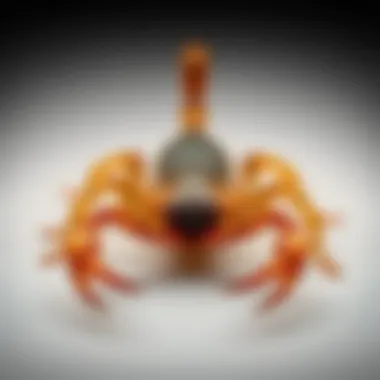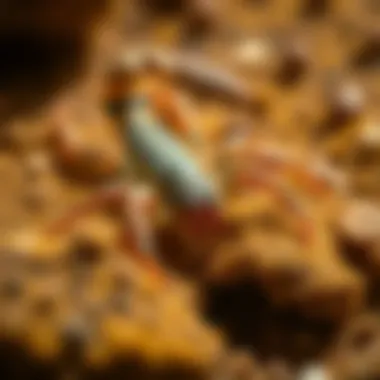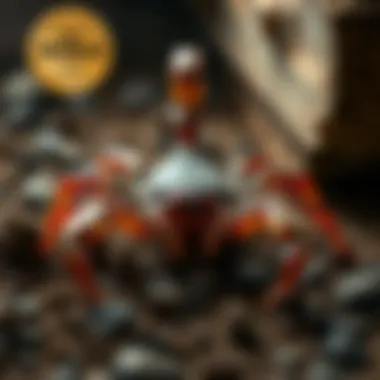Combatting Scorpions in Your Attic: Essential Insights


Intro
Having scorpions in your attic can be a daunting concern for any homeowner. It’s not just about the potential for a sting; it’s the sheer uncertainty that plagues many. What are these creatures doing up there? Are they harmful, or just trying to find a cozy corner to weather out the colder months? In this guide, we will thoroughly explore the world of scorpions and equip you with the knowledge to understand their habits, identify their presence, and implement effective strategies to prevent infestations.
Scorpions, often misunderstood, possess unique biological traits and behaviors that compel them to seek out specific environments—like attics. This article demystifies their biology and discusses why these arachnids might gravitate toward your home. We will also dive into prevention strategies and treatment options to help you regain control of your living space.
Let’s embark on a journey of discovery, understanding, and practical solutions to ensure you can safely manage these eight-legged invaders.
Prologue to Scorpions
Scorpions may not be the first thing that comes to mind when discussing household pests; however, understanding them is crucial for every homeowner. These ancient creatures have thrived for millions of years, and their presence in homes, particularly in attics, can provoke more than just curiosity. Knowing their biology, habits, and the types likely to intrude into living spaces can equip individuals to address potential infestations effectively.
By diving into scorpions' characteristics and behaviors, homeowners can better appreciate the critical aspects of their existence. For instance, realizing that most species pose little danger can help alleviate anxiety concerning their presence. Yet, awareness is also essential because certain species can inflict painful stings, necessitating immediate attention. Thus, understanding the scorpion's biology is an important first step in managing these arachnids in your dwelling.
The Biology of Scorpions
To appreciate scorpions fully, it’s essential to grasp their biology. These creatures are arachnids, related closely to spiders, and have eight legs. A defining feature of scorpions is their segmented bodies, comprising three main parts: the cephalothorax, the abdomen, and the tail. The cephalothorax houses the eyes and mouthparts, while the abdomen contains the vital organs. The tail, often curled upwards, ends with a venomous stinger used for both defense and hunting.
Scorpions are also equipped with specialized sensory organs that can detect even the faintest vibrations in the ground, making them adept hunters. Their exoskeleton is hard and durable, offering protection from predators and environmental conditions. Notably, many scorpions exhibit fluorescence under ultraviolet light due to a substance in their exoskeleton, a fascinating characteristic that aids researchers in studying their behavior in the dark.
Common Species Found in Homes
Not all scorpions pose an immediate threat to humans. Several species have adapted to life in and around homes, particularly in temperate regions. Here are a few that are frequently found:
- Western Black Scorpion (Paruroctonus mesaensis): This species is commonly found in the southwestern United States and is known for its painful sting but is generally not lethal.
- Arizona Bark Scorpion (Centruroides sculpturatus): This one is the most venomous scorpion in North America. Its sting can be potentially dangerous, especially to small children and pets.
- Striped Scorpion (Centruroides vittatus): Often found throughout the central and southern United States, its venom is not considered life-threatening but can cause discomfort and pain.
Understanding these species and their traits is essential for effective management. Scorpions tend to seek shelter in dark, warm, and humid areas, such as attics, which makes being proactive in monitoring these spaces important for homeowners.
Understanding Their Habitat Preferences
Grasping the preferences of scorpions when it comes to their habitats is key for homeowners dealing with these eight-legged nuisances. Knowing where scorpions like to thrive not only builds a better understanding of how to keep them at bay, but it also aids in spotting potential infestations early. Scorpions aren’t just wandering around without purpose; their choices reveal a lot about their behaviors and preferences, providing valuable insight for effective monitoring and prevention.
Why Attics Are Attractive
Attics might seem like a hidden gem to us, but to scorpions, they can feel like a five-star resort. The warmth of the space coupled with the absence of frequent human activity creates an ideal hiding spot. Think about how closely attics resemble their natural environments—dry, secluded, and often structurally complex, giving these creatures plenty of spots to tuck away. These environments offer protection from predators and ample hunting opportunities for their prey, which typically includes insects.
"An attic provides both safety and comfort for scorpions, encouraging them to take up residence there."
Consider these factors that underline the appeal of attics:
- Minimal Disturbance: Humans tend to avoid attics, making it a low-traffic zone where scorpions can roam freely without worry.
- Temperature Fluctuations: Attics often retain heat during colder seasons, creating a cozy spot for scorpions looking to escape the elements.
- Access to Prey: Many insects, which scorpions feast upon, are often found in attics. This proximity ensures a steady food supply, reducing the need for scorpions to wander far.
By understanding why scorpions are drawn to attics, homeowners can take tailored measures to ensure these spaces remain off-limits.


Environmental Conditions Favoring Scorpions
Environmental factors play a massive role in the presence and population of scorpions in a given area. Underlying these factors are aspects like moisture levels, temperature, and food availability, all contributing to how well scorpions can survive and thrive.
- Humidity Levels: Scorpions seek out areas that are neither too dry nor overly damp. A well-ventilated attic that has a balanced moisture level is appealing, as this environment provides what they need to prevent dehydration.
- Temperature: Scorpions are ectothermic, meaning their body temperatures rely on external conditions. Attics that reach warmer temperatures during the day create an inviting atmosphere for these critters, especially if adjacent spaces cool down at night.
- Structural Concerns: The design of a home can inadvertently lend itself to scorpions' survival. Gaps in insulation or cracks in walls provide entry points, while also allowing critters inside to thrive. A poorly insulated attic can act as a bridge for scorpions to enter.
In summary, being aware of these environmental considerations allows homeowners to recognize factors that might inadvertently invite scorpions into their living spaces. Adjusting conditions in attics and identifying possible entry points are fundamental strategies in managing what could become a significant nuisance.
Identifying Scorpion Activity
Identifying scorpion activity is crucial for homeowners who want to maintain a safe and secure living environment. Recognizing the signs of their presence not only helps in addressing a potential problem early but also aids in understanding how to effectively remove them. Scorpions can be elusive, often hiding in dark corners, making it challenging to spot them directly. Thus, being aware of the indirect indicators of their presence becomes essential. Knowing these signs can also save time and resources, as it directs efforts toward the right solutions.
Signs of Infestation
When it comes to scorpions, there are several telltale signs that can alert you to their activity in your attic:
- Shedding Skins: Scorpions molt as they grow, and these discarded exoskeletons can often be found in areas where they live. Finding these skins is one of the clearest signs you have a scorpion inhabitant.
- Droppings: Scorpion droppings may appear as small black particles, resembling ground pepper. If your space has dark corners or low light, check for this indication of their presence.
- Stings: Perhaps one of the most concerning signs, if someone in your household experiences a sting, it may suggest that scorpions are nearby. It’s essential to monitor for any health issues liable to arise from stings.
- Footprints or Tracks: In dust or soft soil, you might occasionally find faint tracks. They may be hard to spot due to their small size, but they are an indication of movement.
- Live Sightings: Seeing a live scorpion is the most definitive sign of an infestation. If you come across one, take note of where you found it, as it can lead to understanding their nesting areas.
Keeping an eye out for these signs ensures a proactive approach toward addressing potential problems before they escalate.
Common Misconceptions About Scorpions
There are several myths and misunderstandings surrounding scorpions that can lead to unnecessary worry or the wrong approach to problem-solving. Here are a few common misconceptions:
- "All Scorpions Are Dangerous." While some species can be harmful, not all scorpions are venomous or pose significant health risks. Many are harmless and merely serve as natural pest control.
- "They Only Come Out at Night." Although scorpions are primarily nocturnal, they can be found at any time, especially if they are disturbed. This is crucial to remember if you believe you are safe during the day.
- "If You Kill a Scorpion, It Will Bring More." This notion suggests that killing one attracts others, but it isn’t true. Scorpions are solitary creatures, and one dead scorpion will not summon its peers.
- "They Only Live in Dry Areas." In reality, scorpions can inhabit a broad range of environments, including damp or somewhat humid areas. Their adaptability surprises many homeowners.
- "Scorpions Are Attracted to Dirt and Mess." While clutter can provide hiding spots, scorpions are primarily seeking shelter, moisture, and food sources rather than dirt itself.
Addressing these misconceptions can help homeowners respond appropriately to a potential infestation, thus enabling better prevention and control strategies.
Potential Threats Posed by Scorpions
Scorpions, though often regarded as mere nuisances, present significant threats that homeowners cannot overlook. Understanding these risks is crucial not just for peace of mind but also for the safety of your household. This section delves into the two primary threads scorpions pose: health risks from their stings and the impact they can have on the overall atmosphere within a home. Armed with this knowledge, you stand a better chance of managing these creatures effectively.
Health Risks Associated with Scorpion Stings
When discussions arise surrounding scorpions, it's common to gravitate towards scare tactics or hyperboles. However, the truth is grounded in reality – scorpion stings can indeed be painful and, in rare cases, fatal, particularly for vulnerable groups such as children, the elderly, or those with compromised immune systems.
While most scorpion stings induce nothing more than mild discomfort, like a bee sting, there are some species, such as the Arizona Bark Scorpion, whose venom is far more potent. Symptoms of a sting may include:
- Severe pain and swelling at the site of the sting
- Numbness or tingling in the affected area
- Difficulty breathing (in rare cases)
It's wise to treat any sting seriously, especially if symptoms escalate. Always consult a medical professional for advice, especially if the sting site becomes infected or shows worrying symptoms.
Awareness of your local scorpion species can also mitigate risks; knowing that a particular type poses a greater threat informs your responses to potential incursion. This knowledge can be life-saving.


Impact on Household Peace
Scorpions can instigate an air of unease, particularly if spotted in people's homes. Uninvited guests, particularly ones with stingers, can vastly alter the dynamics of what a home should feel like – safe and comfortable. Their mere presence is often enough to keep residents on edge, peering into shadows and searching for signs of more invasive antics from these eight-legged creatures.
The psychological effects should not be dismissed. Living with an awareness of scorpions in the attic can lead to:
- Increased anxiety – Homeowners may find themselves more stressed, worrying about stings or potential infestations.
- Disrupted sleep – Nighttime can become fraught with fears of encountering a scorpion. People may change sleeping locations or patterns out of fear.
- Social effects – Entertaining guests might lead to uneasiness, as hosts could fret over scorpions creeping into social events.
This disturbance in peace highlights the need for effective control measures. A home should be a sanctuary, free from the concerns that scorpions may draw upon one's mental space.
Resilience against such disturbances comes from understanding the threats posed by scorpions alongside appropriate intervention strategies, ensuring your home remains a safe and welcoming environment.
Preventing Scorpions in Your Attic
Preventing scorpions in your attic is a critical piece of the puzzle when it comes to safeguarding your home. Knowing how to keep these creatures at bay not only protects your living space but also contributes to your peace of mind. While scorpions aren’t exactly the most troublesome vermin in urban areas, they can quickly transform from a casual curiosity to a serious concern if steps are not taken to minimize their presence. Key practices in this realm often center around maintenance and environmental adjustments.
Through the course of this discussion, we will explore effective home maintenance practices and essential environmental modifications that can firmly place you on the right side of scorpion prevention. Just understanding the significance of these strategies equips homeowners to be proactive rather than reactive.
Home Maintenance Practices
Regular home maintenance is the bedrock of pest management, as it helps ensure that your living quarters are as inhospitable as possible for scorpions. One glaring reminder is that clutter is the enemy. Any items like stacks of newspapers, old shoes, and even decorative boxes pushed into corners provide nifty hideouts for scorpions. Keeping the attic clean is a straightforward yet essential step. Here are several practices to consider:
- Seal Cracks and Gaps: Check for any open seams or cracks in the walls, doors, and windows. Ensuring that these gaps are sealed—particularly in crawl spaces—makes it harder for scorpions to slip in. Use caulk or expanding foam for effective closure.
- Inspect Storage Areas: If your attic is a warehouse for holiday decorations or old furniture, keep an eye on how these objects are stored. Elevate items off the floor on racks if possible. This change not only improves air circulation but also minimizes potential nesting points for scorpions.
- Maintain Landscaping: It's not just the home itself; the outside counts, too. Trim back shrubs and keep branches away from the roofline. Scorpions may use these pathways to gain entry into your home, so your yard should not act as a bridge to your attic.
- Regular Pest Control Checks: Having a pest control expert conduct periodic inspections can pinpoint problem areas and advise on necessary measures. A second pair of eyes for prevention can save you a headache down the line.
Effective Control Strategies
When it comes to managing the presence of scorpions in your attic, effective control strategies are paramount. These strategies serve not merely as quick fixes but as integral components of long-term pest management plans. It’s crucial to understand that having scorpions in your home is not just an inconvenience; it can also pose potential health risks and emotional stress. Homeowners must equip themselves with knowledge about different control methods, allowing for a response that is both appropriate and effective.
Having a clear strategy in place can prevent the problem from escalating. Whether it's utilizing natural or chemical solutions, integrating multiple methods can often yield the best results.
Natural Repellents
Natural repellents are emerging as an increasingly popular choice for homeowners who prefer methods that minimize chemical usage. Certain substances can deter scorpions effectively without introducing harsh chemicals into your living space.
Consider incorporating these natural solutions:
- Essential Oils: Scorpions are sensitive to certain scents. Essential oils like peppermint, cinnamon, and lavender can be potent deterrents. A simple solution involves mixing a few drops of these oils with water in a spray bottle and applying it in areas of active scorpion movement.
- Diatomaceous Earth: This natural powder can help in preventing scorpions from establishing a foothold in your attic. It is non-toxic to humans and pets. Sprinkling it around entry points can disrupt their movement, leading them to seek more hospitable environments.
- Citrus Peels: It may sound peculiar, but scorpions tend to detest citrus fragrances. Placing citrus peels around areas where you notice them can act as a simple yet effective repellent.
Keep in mind, however, that while natural repellents can help, they may not be foolproof. Regular monitoring and inspection continue to be important as these methods may need repetition to maintain effectiveness.
Chemical Solutions
For more immediate results or in cases of severe infestation, chemical solutions could become necessary. These solutions can bring about rapid control of scorpions but should be utilized carefully to avoid adverse effects on household members and pets.


Here are key elements related to chemical control:
- Insecticides: Look for insecticides labeled for scorpion control. When applying, follow the instructions closely. Target both the areas where scorpions are likely to hide and entry points where they might gain access. Often, formulations that contain pyrethroids are effective against these pests.
- Boric Acid: This common household item acts as a slow-acting poison for scorpions. Applying it in cracks and crevices can yield long-term results, as it takes time for the scorpions to ingest it, thus ensuring that they cannot survive for long periods after contact.
- Professional Treatments: In cases where infestations seem to evade all efforts, hiring a pest control professional may be necessary. They have access to stronger chemicals that can get the job done effectively. Professionals typically conduct a thorough inspection and apply treatments that you might not have access to as a homeowner.
Remember, while chemical solutions can offer swift results, integrating them with natural methods can create a comprehensive control strategy, ultimately enhancing their effectiveness.
Effective control strategies require vigilance and adaptability. Be proactive, consistent, and observant to keep your home scorpion-free.
When to Call Professionals
Addressing a scorpion issue in your attic can quickly become a daunting task for many homeowners. While there are preventive measures and natural repellents to consider, there comes a point when seeking the help of professionals is advisable. This segment explores the reasons behind enlisting expert assistance, ensuring you have a better grasp on when it’s time to step back and let the pros handle it.
It’s essential to recognize that not all scorpion encounters are equal. Some situations can be resolved with minimal intervention, while others can escalate quickly, posing more risks than initially perceived. The peace of mind that comes with professional pest control cannot be overstated. Experts have the skills, knowledge, and tools that may be outside the typical homeowner’s reach, making sure that the problem is addressed correctly and efficiently.
Signs That Require Expert Help
Several key indicators can signal that it may be time to consult with a pest control service:
- Frequent Sightings: Spotting scorpions regularly or finding them in various places around your home is a sure sign of an infestation. If you’re discovering them near living areas or sleeping spaces, it's particularly pressing to act.
- Recurrent Stings: If anyone in your household has experienced multiple stings, it's alarm bells ringing. Not only is this dangerous, but it also indicates that scorpions are thriving within your home.
- Failure of DIY Methods: Trying out various DIY solutions like traps or repellents without success suggests that the population might be larger than anticipated. If methods fail, it’s time to call in the cavalry.
- Visible Nests or Clusters: Finding scorpion nests or multiple individuals together means you are looking at a robust colony that might need a more specialized approach.
"When it comes to scorpions, it’s best to err on the side of caution. Some species, such as the Arizona Bark Scorpion, can pose serious threats, especially to children and pets."
Choosing a Pest Control Service
Once you’ve determined that professional help is necessary, the next step involves choosing the right pest control service. Not all services are created equal, so here’s how to navigate the selection process:
- Research Local Companies: Start with a quick online search or seek recommendations from neighbors. Areas such as Reddit often have community insights that can guide your choice.
- Check Credentials: Ensure the service has proper licensing and insurance. This protects both you and the company while ensuring they are following relevant pest control laws.
- Read Reviews: Customer feedback is invaluable. Look for experiences related to scorpion control specifically. You'll want to avoid companies that may have great customer service but lack effectiveness in pest management.
- Ask About Methods: Inquire about the techniques they will use to manage scorpions. Companies that offer an integrated pest management approach tend to have a more thorough plan involving prevention, control, and monitoring.
- Get Estimates: Gather several quotes but be wary of unusually low prices—quality service often doesn't come cheap. Look for a fair balance between cost and quality.
Remember, engaging a professional may seem like an extra expense, but when safety, health, and peace of mind are on the line, it’s a smart investment. Keeping an eye out for signs that necessitate expert intervention ensures a proactive rather than reactive strategy for managing scorpions in your attic.
Epilogue
The topic of scorpions in attics is not just a trivia for curious minds; it holds significant implications for both area homeowners and safety. Understanding their behavior, habitat preferences, and the threat they pose can transform an ordinary living space into a secure haven. As one reflects on the points elaborated throughout the article, it’s clear that being aware of the potential pest issues brought by scorpions can empower homeowners.
Understanding the Importance of Awareness
Awareness acts as a foundation for effective pest management. Knowing what scorpions look like, where they tend to hide, and their preferred environmental conditions can save quite a bit of headache. Attack isn’t always the best defense. Instead, it helps to proactively identify signs of infestation – sometimes, you might find these critters making a home of your attic without an immediate sting in sight. Here are a few critical points:
- Identification of Common Species: Understanding the various species helps in gauging the level of risk associated with them.
- Signs of Infestation: Knowing what signs to look for—like shed exoskeletons—can alert homeowners before a situation spirals out of control.
- Behavioral Traits: Recognizing that these creatures often emerge at night may affect how you approach home maintenance and inspections.
"An ounce of prevention is worth a pound of cure."
Exactly! Keeping an eye out means you stay one step ahead. With knowledge, homeowners can also reduce unnecessary panic when they encounter a scorpion. Making an informed response rather than a hasty one can make all the difference.
Long-Term Strategies for Management
To avoid recurring issues with scorpions, strategic, long-term planning is key. While short-term solutions, like using a chemical spray, may provide immediate respite, they don’t tackle the root of the problem. Therefore, a holistic approach might include:
- Regular Inspections: Schedule thorough checks in attics, basements, and other potential hiding spots, especially before the warm months.
- Environmental Modifications: Adjust the surrounding landscape. Keep mulch and debris away from the home’s foundation, as these create perfect nesting spots.
- Entry Point Sealing: caulk cracks & crevices tight, both on the exterior and the interior. This helps in cutting off access routes.
- Collaborative Efforts: Engage neighbors. Scorpions can move from one property to another, so fostering a community-wide pest management strategy can be highly effective.



